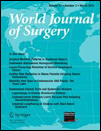Management of Recurrent Inguinal Hernia at a Tertiary Care Hospital of Southern Sindh, Pakistan
Abstract
Background
The goal of the present study was to determine the frequency, mode of presentation, and need for reoperation in the treatment of recurrent inguinal hernia at Liaquat University Hospital, Jamshoro, Sindh, Pakistan.
Methods
This descriptive, cross-sectional study was conducted over a period of four years, from January 2007 through December 2010. A total of 916 patients with inguinal hernia underwent operation in the Department of Surgery at Liaquat University Hospital Jamshoro, Sindh, Pakistan, during the study period. Of them, 62 patients were diagnosed to have recurrent inguinal hernia and were included in the study. Female patients and patients with other types of hernia like femoral, epigastric, and paraumbilical defects were excluded.
Results
Among the 62 patients studied, the commonest age group with recurrence was 41–50 years (43.5 %). Fifty-one (82.2 %) of the patients were ambulatory workers. In 47 cases (75.8 %) recurrence was on the right side, and in 15 (24.1 %) recurrence was on the left side. First time recurrence was seen in 54 patients (87 %) and second time recurrence was seen in 7 patients (11.2 %); third time recurrence was observed in only one patient. All of these patients had an initial open surgery without mesh, except one. Bassini’s repair was done as a primary repair in 47 (75.8 %) cases. A total of 11 patients (17.7 %) had no previous medical records. Darning repair was done in 3 patients (4.8 %), and open surgery with mesh was performed in only one patient. The highest recurrence rates were seen in patients whose hernia repairs had been done by postgraduate trainees. That is, 45 of the patients requiring reoperation (72.5 %), compared to 11 (17.7 %), and 6 (9.6 %) operations performed by registrars and consultants, respectively. All patients in our study underwent tension-free Lichtenstein mesh repair. Postoperative complications included retention of urine (40.3 %), scrotal hematoma (6.4 %), and wound infection (3.2 %).
Conclusions
Recurrent inguinal hernia is still frequently observed today, and the Lichtenstein tension-free repair has gained great acceptance worldwide and is currently considered the procedure of choice for primary and recurrent inguinal hernias.




